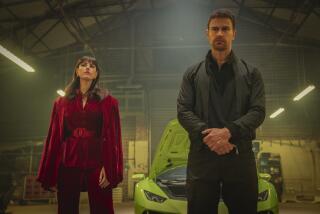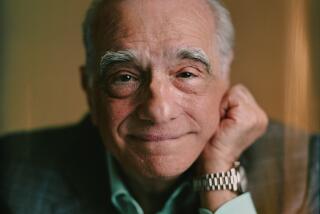Edward Scissorhands at 25 stands the test of time
- Share via
Tim Burton’s beloved “Edward Scissorhands” resembles someone very familiar to the director: himself.
That’s because screenwriter Caroline Thompson based her lead character on a mash-up of Burton, Frankenstein and Thompson’s dog at the time, Ariel. The result: A man with metal hands but a heart of gold, living the life of an outsider in a pastel paradise known as suburbia.
Just as audiences embrace Burton’s quirkiness as a filmmaker, they instantly became infatuated with Scissorhands as embodied by the director’s favorite leading man, Johnny Depp. While much has changed in the fantasy-horror movie genre since “Edward Scissorhands” hit theaters 25 years ago, Burton’s film is still firmly part of pop culture.
To commemorate “Edward Scissorhands’” 25th anniversary, 20th Century Fox Home Entertainment released a limited-edition DVD of the 1990 film, which starred Depp and Winona Ryder, with Dianne Wiest as suburban saleswoman Peg and Vincent Price as Scissorhands’ eccentric inventor.
SIGN UP for the free Indie Focus movies newsletter >>
“The film has a certain longevity with audiences,” says Jennifer McMahon, professor and editor of “The Philosophy of Tim Burton.” “Burton, as a student of culture, is consistently situating himself and constructing works that resound cultural traditions in a unique and interesting way.”
In the case of “Edward Scissorhands,” McMahon says Burton succeeded in rendering a “highly sympathetic portrayal of a monster,” much like Mary Shelley did with “Frankenstein.”
Britt Salvesen, who curated the 2011 Tim Burton exhibition at the Los Angeles County Museum of Art, says that, though “Edward Scissorhands” is part of the fantasy-horror genre, it addresses the more universal feeling of being an outsider.
“I feel like this movie is so important in Burton’s overall work because of the way that the character is a surrogate for himself growing up in Burbank and how he personified that in these really surprising ways,” Salvesen says. “And yet this character is also someone so many other people could identify with, as weird as he is.”
It’s true: Much of the film’s setting is inspired by Thompson’s and Burton’s memories of Burbank, where they both lived at different times in their lives.
“I thought of Edward as related to those sad characters like Frankenstein,” Thompson says. “Edward was also based on Tim and my dog. If she had the power of speech, she surely would have talked, she was that interested in everything.”
Thompson says the first time Burton showed her his sketch of Edward Scissorhands was at a small bar in Santa Monica in 1985. The two were hoping to collaborate on a project because they shared what Thompson describes as a love of “odd, skewed ideas.”
Burton’s drawing, done years earlier while he was a student at Burbank High School, was a simple pen, ink and pencil sketch of a man with disheveled black hair, wide eyes and scissors as hands.
“Sometimes something just strikes you,” Thompson says. “I had a bolt of clarity about what to do with the image. I went home and wrote a 70-page novelization of the drawing.”
A couple of years later, Fox was on board with the film, which was made on a fairly modest budget of about $20 million, Thompson says. Studio executives, including the then-head of Fox, Scott Rudin, were extremely hands off, per Burton’s request.
“It was my first film, and it was one of those rare experiences where everybody was really making the same movie,” Thompson says. “We all had the same tone and same idea of what we were after. From production designer Bo Welch’s sets to Colleen Atwood’s costumes to Danny Elfman’s music.... I didn’t realize what a dream come true it was.”
These days, Thompson doesn’t think Hollywood would take a risk and make a film as out of the box as “Edward Scissorhands.”
“There’s not the kind of ‘let’s give it a shot’ attitude that was still there a little bit when I started working in Hollywood. I have no idea what they would say [if I gave them the script now]. I suspect studio execs would want practical questions about Edward’s character answered, like how he would go to the bathroom with scissors as hands? But explaining that would be like pulling a piece of yarn in the sweater and the whole thing unraveling. The story doesn’t hold up to logic because it’s not logic. It’s an emotional story. It’s a fable.”
saba.hamedy@latimes.com
ALSO:
R.L. Stine reveals his most gruesome scene ever
‘Pan’: The Great PG Revolution is not off to a great start
Review: ‘The Assassin’ kills it with emotional resonance and martial arts moves
More to Read
The biggest entertainment stories
Get our big stories about Hollywood, film, television, music, arts, culture and more right in your inbox as soon as they publish.
You may occasionally receive promotional content from the Los Angeles Times.











